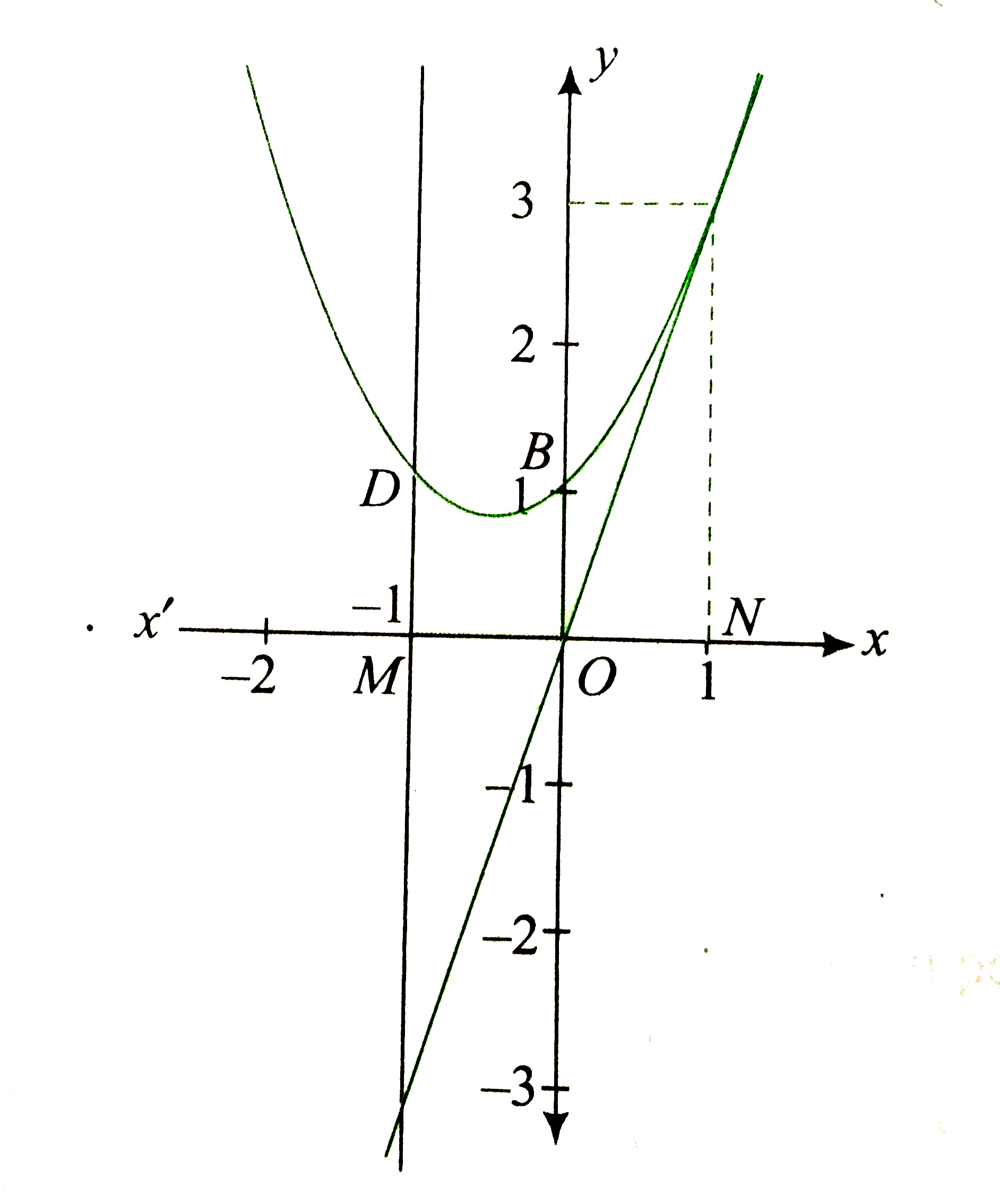The area of the closed figure bounded by x=−1,y=0,y=x2+x+1, and the tangent to the curve y=x2+x+1 at A(1,3) is (a) 43 sq. units (b) 73 sq. units (c) 76 sq. units (d) none of these Solution in Bengali
(a) 4/3 sq. units
(b) 7/3 sq. units
(c) 7/6 sq. units
(d) None of these
The correct Answer is:C
Given y=x2+x+1=(x+12)2+34⇒y−34=(x+12)2.

This is a parabola with vertex at (−12,34) and the curve is concave upwards.
y=x2+x+1ordydx=2x+1or(dydx)(13)=3
Equation fo the tangent at A(1,3)isy=3x
Required (shaded) area = Area ABDMN-Area ONA
Now, area ABDMN=1∫−1(x2+x+1)dx=21∫0(x2+1)=83
Area of ONA=12×1×3=32.
∴ Required area =83−32=16−96=76 sq. units
Topper's Solved these Questions
- AREABOOK - CENGAGE PUBLICATIONCHAPTER - AREAEXERCISE - Multiple Correct Answers Type
13 Videos
- AREABOOK - CENGAGE PUBLICATIONCHAPTER - AREAEXERCISE - Linkded Comprehension Type
21 Videos
- AREABOOK - CENGAGE PUBLICATIONCHAPTER - AREAEXERCISE - Concept Application Exercise 9.3
7 Videos
- APPLICATIONS OF DERIVATIVESBOOK - CENGAGE PUBLICATIONCHAPTER - APPLICATIONS OF DERIVATIVESEXERCISE - Subjective Type
2 Videos
- BINOMIAL THEOREMBOOK - CENGAGE PUBLICATIONCHAPTER - BINOMIAL THEOREMEXERCISE - Comprehension
11 Videos
Similar Questions
Let A(k) be the area bounded by the curves y=x2−3 and y=kx+2 The range of A(k) is (10√53,∞) The range of A(k) is (20√53,∞) If function k→A(k) is defined for k∈[−2,∞ ), then A(k) is many-one function. The value of k for which area is minimum is 1.
View SolutionLet Ar be the area of the region bounded between the curves y2=(e−kr)x(where k>0,r∈N) and the line y=mx(where m≠0), k and m are some constants
A1,A2,A3,… are in G.P. with common ratio
View SolutionFind the continuous function f where (x4−4x2)≤f(x)≤(2x2−x3) such that the area bounded by y=f(x),y=x4−4x2. then y-axis, and the line x=t, where (0≤t≤2) is k times the area bounded by y=f(x),y=2x2−x3,y-axis , and line x=t(where0≤t≤2).
View SolutionProve that for λ>1, the equation xlogx+x=λ has least one solution in [1,λ].
View SolutionConsider a G.P. with first term (1+x)n, |x|<1, common ratio 1+x2 and number of terms (n+1). Let 'S' be sum of all the terms of the G.P., then
The coefficient of xn is 'S' is
View SolutionThe area bounded by the parabola y=(x+1)2 and y=(x−1)2 and the line y=14 is (A) 4 sq. units (B) 16 sq. units (C) 34 sq. units (D) 13 sq. units
View SolutionThe area bounded by the curve y=4x−x2 and x-axis is (A) 307 sq. units (B) 317 sq. units (C) 323 sq. units (D) 343 sq. units
View SolutionThe area of the region bounded by the curves y=|x−1| and y=3−|x| is (A) 6 sq. units (B) 2 sq. units (C) 3 sq. units (D) 4 sq. units
View SolutionLet f(x)=min(x+1,√1−x) for all x≤1. Then the area bounded by y=f(x) and the x-axis is (a) 73 sq units (b) 16 sq units (c) 116 sq units (d) 76 sq units
View SolutionThe area bounded by the curves y=logex and y=(logex)2 is (A) e−2 sq. units (B) 3−e sq. units (C) e sq. units (D) e−1 sq. units
View SolutionThe area bounded by the curves y=|x|−1andy=−|x|+1 is 1 sq. units (b) 2 sq. units 2√2 sq. units (d) 4 sq. units
View SolutionThe area bounded by the parabolas y=(x+1)2 and y=(x−1)2andy=(x−1)2 and the line y=14 is 4 sq. units (b) 1/6 sq. units 4/3 sq. units (d) 1/3 sq. units
View SolutionThe area of the closed figure bounded by x=−1,y=0,y=x2+x+1, and the tangent to the curve y=x2+x+1 at A(1,3) is (a) 43 sq. units (b) 73 sq. units (c) 76 sq. units (d) non of these
View SolutionThe area bounded by the curves y=|x|−1andy=−|x|+1 is 1 sq. units (b) 2 sq. units 2√2 sq. units (d) 4 sq. units
View SolutionThe area of the triangle formed by the line x=3, y=4 and x=y is (a)12sq.unit (b)1sq.unit (c)2sq.unit (d) None of these
View SolutionThe area bounded by the curve y=4x−x2 and x-axis is (A) 307 sq. units (B) 317 sq. units (C) 323 sq. units (D) 343 sq. units
View Solution
